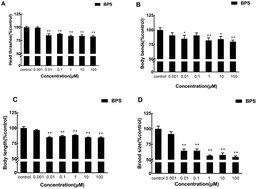Toxicity and multigenerational effects of bisphenol S exposure to Caenorhabditis elegans on developmental, biochemical, reproductive and oxidative stress†
Abstract
Bisphenol A (BPA) is a typical endocrine disruptor. Bisphenol S (BPS) has been widely used as a substitute for various plastic materials due to the limited application of BPA. However, it does not mean that BPS is a safe substitute due to the lack of effective evaluation of BPS. In this study, the clinical model of Caenorhabditis elegans (C. elegans) was used to study the effects of BPS on the locomotion behavior, growth, reproduction, lifespan and antioxidant system. Our study found that C. elegans exposed to 0.01 μM BPS could have significantly inhibited locomotion behavior and growth, as well as damaged reproductive and antioxidant systems and lifespan. It is interesting to note that in multi-generational exposure studies, we found that BPS exhibits complex genotoxicity. With the transmission to the offspring, BPS showed more significant inhibition of the head thrashes of the nematode, while the effect on the body bends and body length was gradually weakened. The effect of BPS on the brood size shows different rules according to different concentrations and offsprings. Therefore, the safety of BPS still needs further evaluation, especially the multi-generational genotoxicity.



 Please wait while we load your content...
Please wait while we load your content...